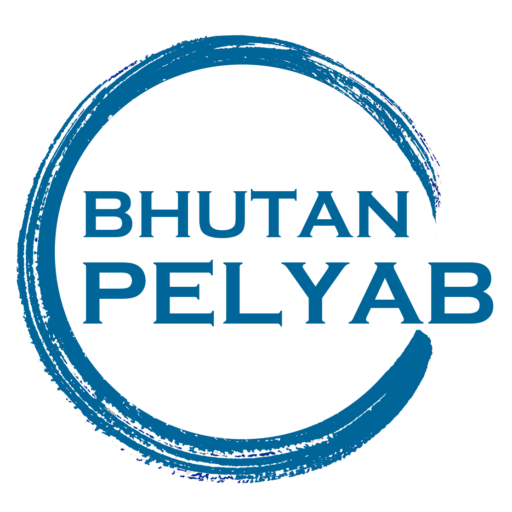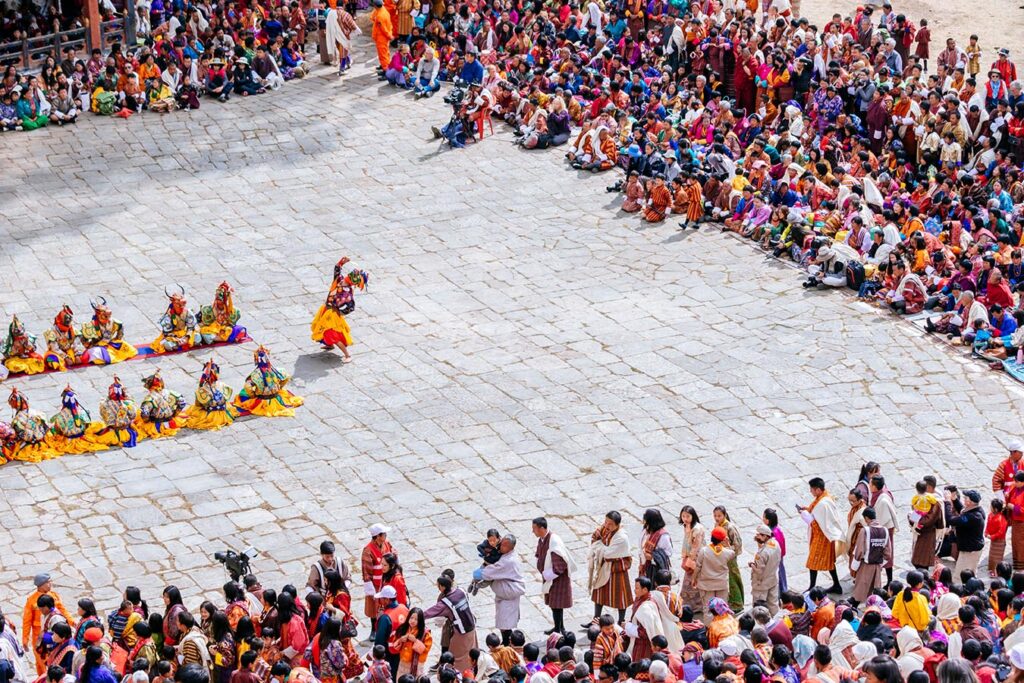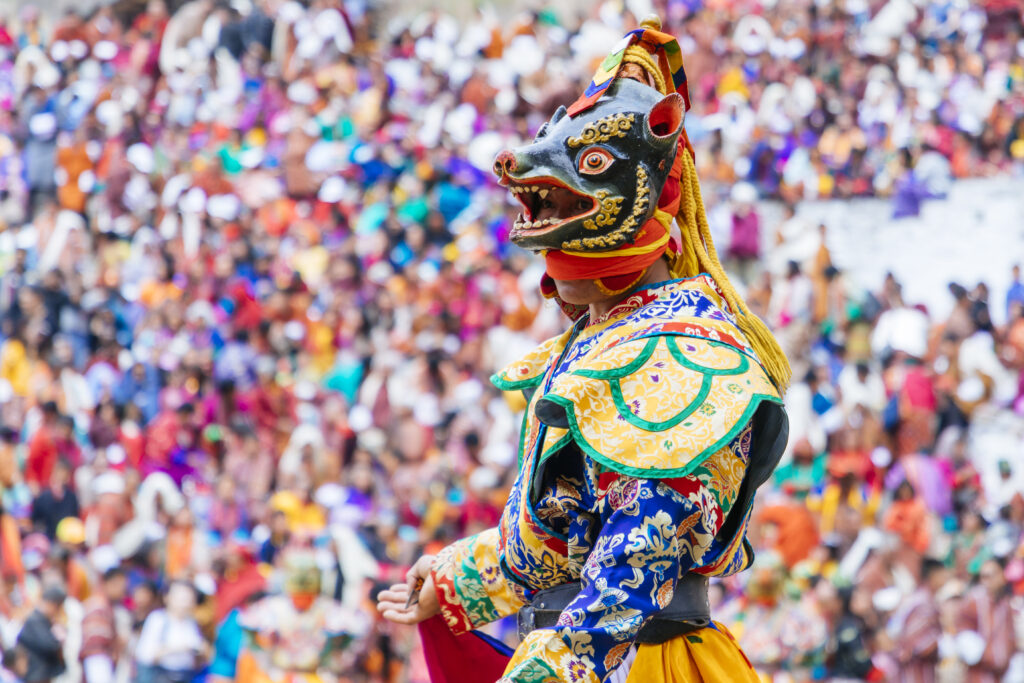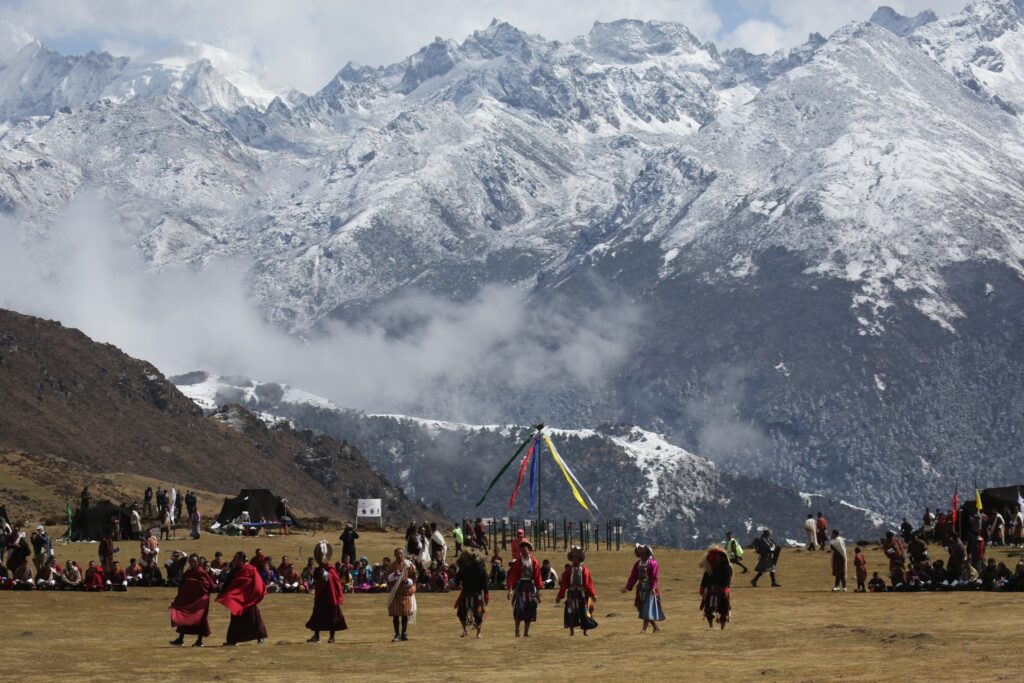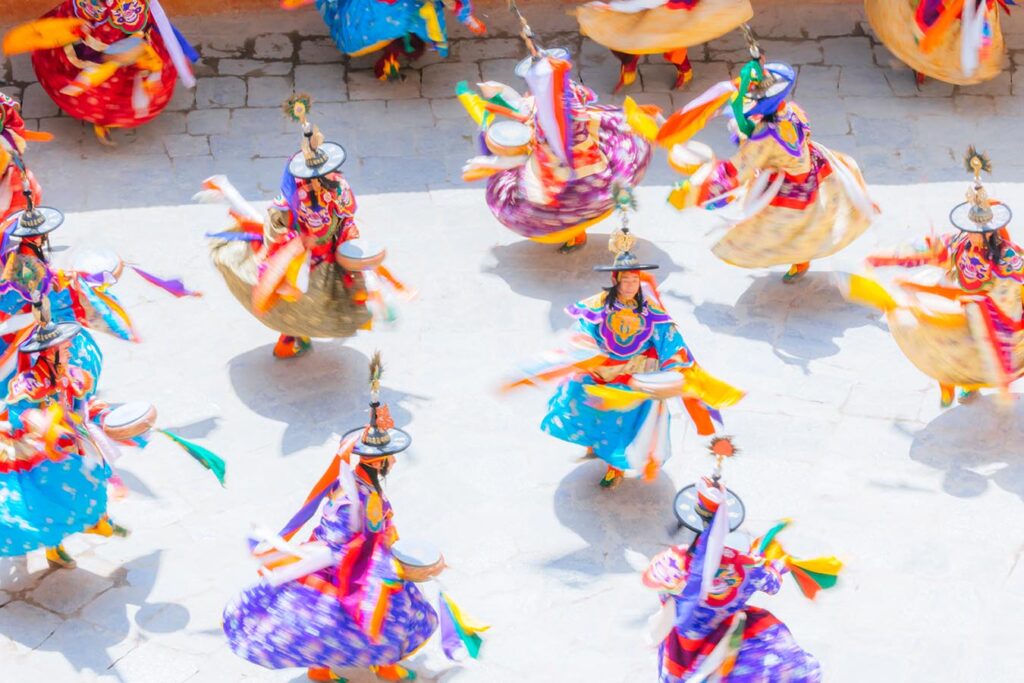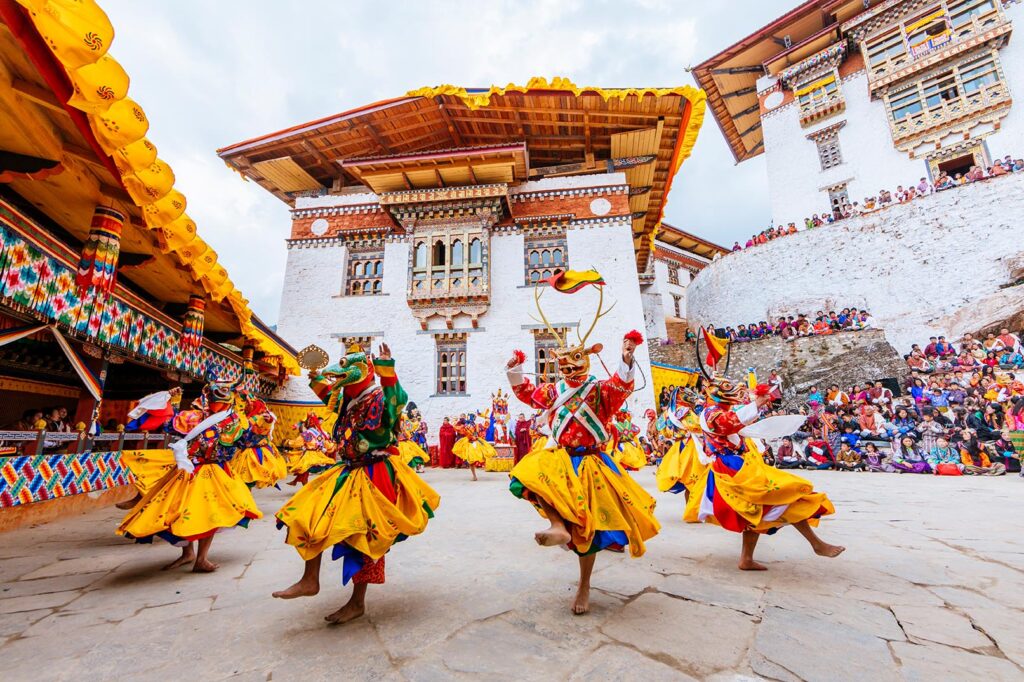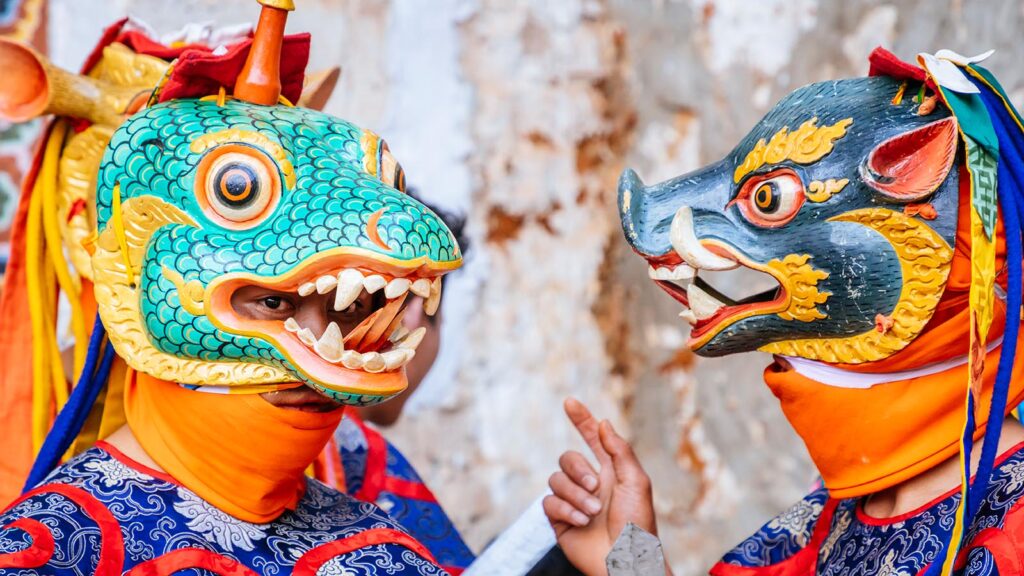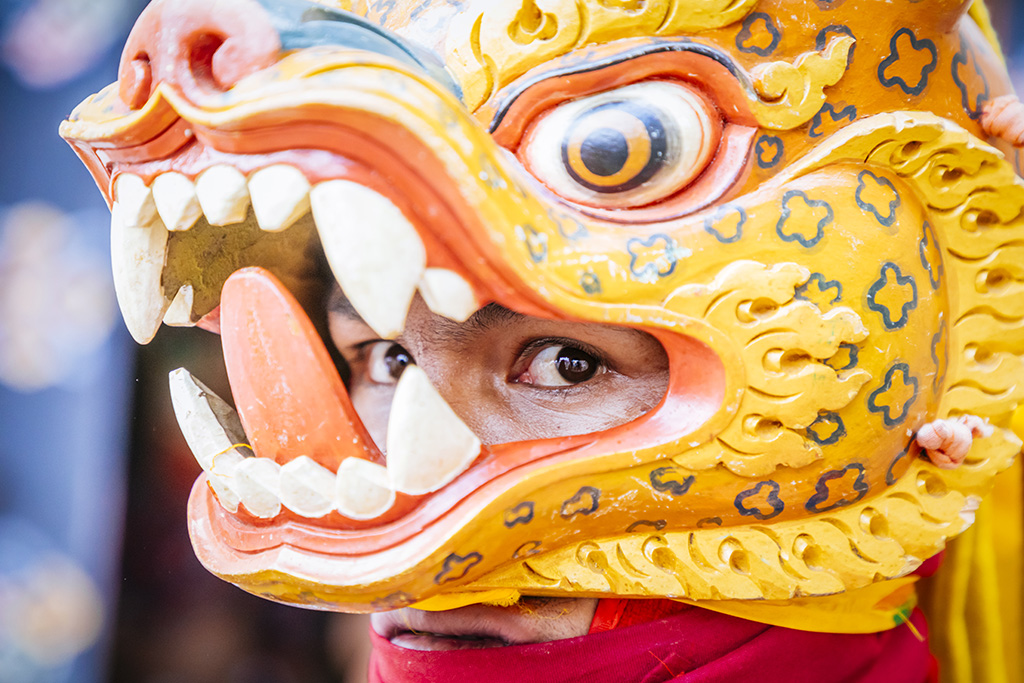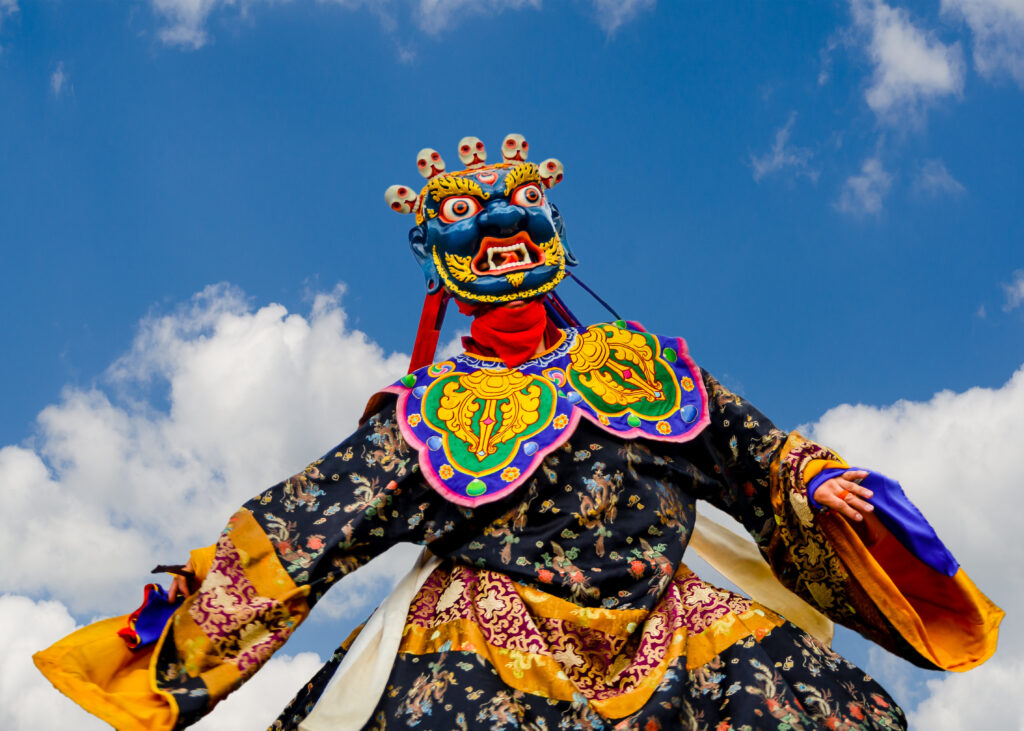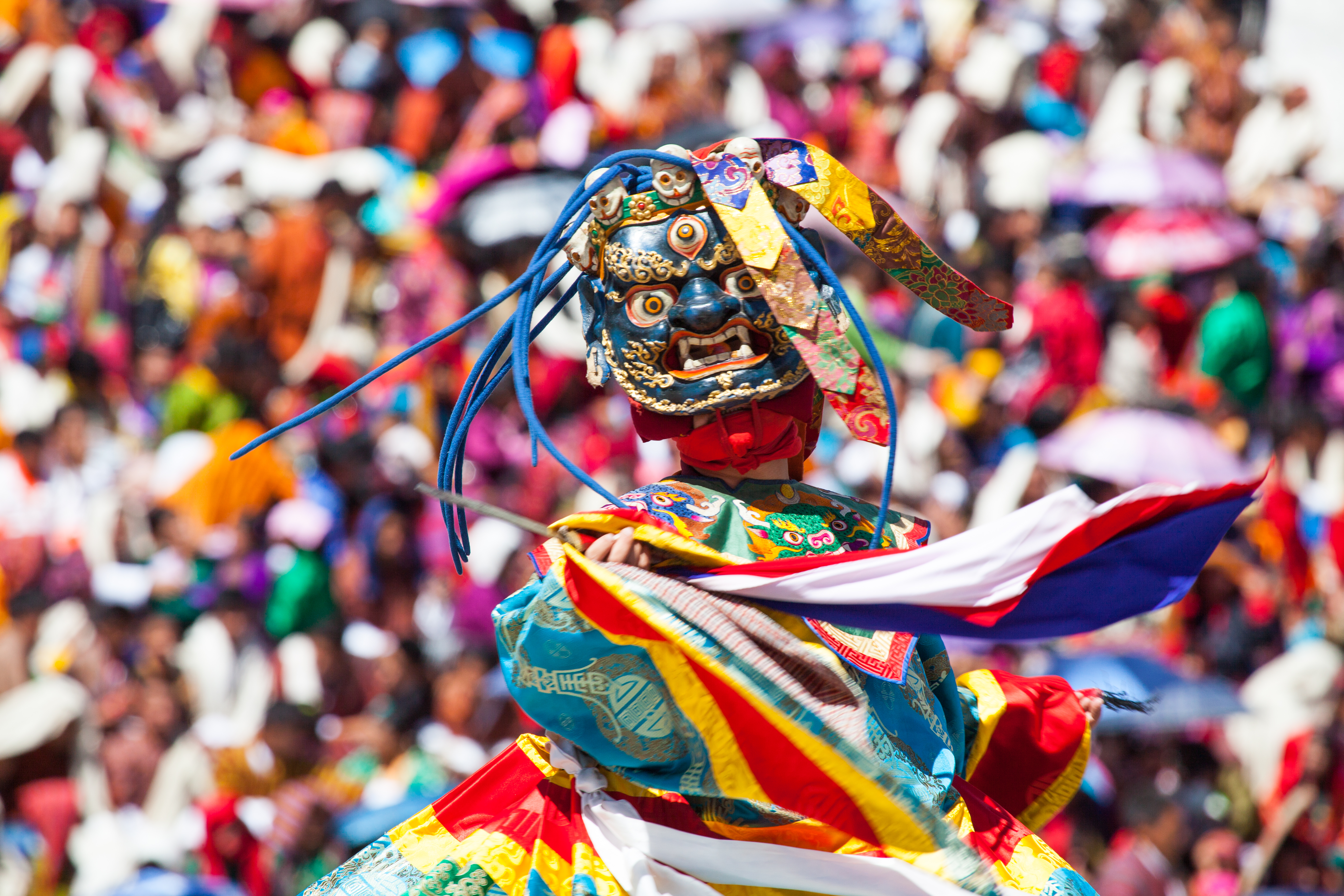
Tour duration: 07 nights/ 08 days
Tour destinations: Thimphu, Punakha, and Paro
Tucked away in the folds of the mighty Himalayas, the Kingdom of Bhutan guards its ancient traditions and pristine natural landscapes. It’s the vibrant Buddhist festivals, however, that offer an enthralling window into the soul of this enigmatic land.
Join us on a 7-night, 8-day journey that immerses you in the heart of Bhutan’s festival season, featuring the cherished Talo Tshechu in the serene Punakha Valley. Experience this vibrant festival filled with sacred ceremonies and captivating mask dances celebrating the kingdom’s Buddhist heritage.
A true highlight is witnessing the revered Zhungdra, a classical song-and-dance of the ancient Mani-sum genre, performed by the renowned Talo dance troupe.
During your journey, you’ll also explore Bhutan’s most enchanting destinations – Thimphu, Punakha, and Paro. Discover the capital’s unique blend of tradition and modernity. Marvel at iconic dzongs and monasteries, including the cliffside Tiger’s Nest in Paro.
This tour is a complete immersion into the Buddhist philosophical depths, ethnic traditions, and breathtaking Himalayan scenery that make Bhutan the Last Shangrila. An experience that will awaken your soul.
Day 01: Arrive in Paro and travel to Thimphu
- Distance: 55km
- Estimated travel time: 1.30hrs
Welcome to Bhutan, the stunning Himalayan kingdom where hidden beauty awaits at every turn. Each step you take will unveil unique cultural experiences, captivating historical tales, and the enchantment of tranquility.
As your plane descends towards Paro (2,280m), you’ll be greeted by breathtaking views of the mighty Himalayan peaks. Upon arrival at the airport nestled in this fertile valley, our guide will warmly welcome you. Your incredible Bhutanese adventure has now begun!
For the scenic 1.5-hour drive to Thimphu, the lively capital, you’ll follow the tranquil Pachu River, catching tantalizing glimpses of Bhutan’s unspoiled natural splendor along the way. Enjoy the serenity of the surrounding lush greenery and pristine waters as rejuvenating energy washes over you.
Thimphu, Bhutan’s lively capital and largest city, lies in the heart of the western central region. Proclaimed the capital by the third king in 1961, it transformed into the country’s administrative and economic hub. While the city center bustles with modern buildings, just beyond, you’ll find the serenity of blue pine forests. Thimphu gracefully blends Bhutanese culture with embracing modernity. Here, you’ll experience the kingdom’s rich cultural heritage harmoniously coexisting with 21st century vision.
After checking into your hotel, it’s time for you to begin exploring the capital’s wonders at the striking National Memorial Chorten. This is a place of daily worship for the Bhutanese people. The striking stupa with golden spires seems to glow under the sun, catching your eye from afar. The Third King originally constructed the chorten to pray for world peace, and now it also serves as a memorial to him.
You can also take a quick trip to the General Post Office. Here, you’ll have the chance to have your own personalized stamp made – definitely a unique souvenir from Bhutan to take back home!
Next, visit the Buddha Point (Buddha Dordenma Statue), perched atop a hill in Kuenselphodrang Nature Park. This colossal 51.5-meter Shakyamuni statue is one of the tallest Buddha statues in the world. Visible from afar, it was constructed to fulfill an ancient prophecy believed to emanate peace and happiness globally. Seeing the statue and feeling the essence of tranquility in this area will be a profound moment.
In the afternoon, your journey will continue to the picturesque Motithang suburb for the Wangditse Nature hike (2,400m). This relatively easy 2.5km trail winds through enchanting oak, blue pine, and rhododendron forests. It will take you 2 hours to complete, providing an excellent chance for a forest bath where you can stay close and absorb the energy of nature.
Along the way, you’ll stop at the Motithang Takin Preserve to see Bhutan’s unique national animal, the takin, with its distinct cow-goat hybrid appearance. You’ll also visit the ancient Druk Wangditse Lhakhang, one of Thimphu’s oldest and most significant heritage temples.
The hike is adorned with vibrant strings of prayer flags, adding a splash of color to the scenic route. You can stop and soak in the breathtaking views of Samteling Palace, Tashichho Dzong, and the entirety of Thimphu Valley. This hike promises a delightful walk through nature and a journey through some of Bhutan’s most cherished landmarks.
You will stay overnight at the hotel in Thimphu.
Day 02: Thimphu sightseeing
This morning, your exploration of Thimphu will begin with a moderate uphill hike to the revered Tango Monastery (2,800m). The 400m elevation gain will lead you through lush forests of blue pines, oaks, rhododendrons, and alpine woods. After about an hour of hiking, you’ll be rewarded with arrival at this important Buddhist learning center located north of the capital.
Tango Monastery is known as the highest level of monastic training in Bhutan, equivalent to a master’s degree. Many of the country’s esteemed religious leaders, locally known as Je Khenpos, have undergone the nine-year program at this ancient monastery. Experiencing the serene atmosphere will provide a fascinating glimpse into Bhutan’s deep Buddhist traditions.
Later, visit the National Institute for Zorig Chusum, commonly called the ‘Arts and Crafts School’ or ‘Painting School’. There’s no better place to gain insights into Bhutan’s incredible traditional arts than by seeing the students’ skills on display here. You’ll have the chance to watch young craftsmen diligently practicing the intricate art forms of painting, embroidery, wood carving, and more. Witnessing their dedication to mastering each craft is truly inspiring.
After enjoying some time for lunch, your cultural immersion will continue at the Jungshi Handmade Paper Factory, conveniently located just 1km from Thimphu’s center. Here you’ll learn about the exciting traditional methods used to produce the distinctive Dehsho paper made from the bark of the daphne and dhekap trees. This handmade paper is an integral part of Bhutan’s heritage, used for woodblocking, manuscripts, and sacred prayer books.
The last destination today will be the famous Tashichho Dzong (Fortress of The Glorious Religion). Originally built in 1216 A.D., this impressive fortress of Bhutanese Buddhism has been reconstructed over the centuries, with the latest renovations completed in 1952 under King Jigme Dorji Wangchuck. The spectacular dzong sits majestically along the Wang Chhu rver, its well-manicured lawns and gardens enhancing the grandeur. The sight of the flag-changing ritual at Tashichho Dzong is also very interesting to watch, so make sure you catch it at 5 p.m.
You will spend the second night at the hotel in Thimphu.
Day 03: Thimphu to Punakha
- Altitude in Punakha: 1,300m
- Distance: 75km
- Estimated travel time: 3hrs
Today, your journey will be eastward from Thimphu to the historic Punakha Valley, the former capital of Bhutan until 1952. One of the nation’s warmest alpine valleys, Punakha promises breathtaking Himalayan vistas, invigorating treks, and serene temples around every bend.
Your first stop will be the renowned Dochula Pass, situated at an elevation of 3,050m. Praised as one of the most picturesque mountain passes in the Himalayas, the view here is simply breathtaking. The sight of 108 chortens dotting the hillside with the backdrop of mighty snowcapped peaks in the distance will surely be one of your most memorable visions of Bhutan.
From the pass, you will head to the iconic Punakha Dzong, also known as the Palace of Great Happiness. Established in 1637 by Ngawang Namgyal, the first Zhabdrung Rinpoche, this magnificent monastery sits at the confluence of the Po and Mo rivers. As the second-oldest dzong in Bhutan, its six floors, including the central utse tower are surrounded by lush green landscapes. Walking through this sacred site promises to be a profound experience.
Next, explore the famous Pho Chhu Suspension Bridge located near Punakha Dzong. At 160 meters, it’s the longest suspended footbridge in Bhutan! As you walk across, take in the serene views of Punakha Dzong and the picturesque valleys and villages around you.
Later, you’ll set off on a scenic 1-hour walk through rice paddies and pine forests to reach Khamsum Yuelley Namgyal Chorten. This splendid chorten sits prominently on a ridge 1,500 meters above the Punakha Valley. A striking example of Bhutanese Buddhist architecture, it features a golden spire and intricately patterned walls that set it apart. The chorten’s location offers breathtaking panoramic views over the entire valley below – the perfect spot to pause and soak in Punakha’s incredible natural scenery!
You will spend the night at the hotel in Punakha.
Day 04: Punakha – Talo Tshechu Festival
After breakfast, we will drive for about 1 hour to reach Talo village to attend the renowned Talo Tshechu Festival. This vibrant festival is held annually from the 8th to the 10th day of the second month of the Bhutanese calendar, which falls from April 5th to April 7th in 2025, at the grounds of the historic Talo Monastery.
Talo is known as the home of the mind incarnations of the Zhabdrung Ngawang Namgyel, the founder of Bhutan. Every year, for three days, people from all over the valley come to the 250-year-old monastery, seeking spiritual blessings and admiring the traditional sacred mask dances.
The Talo monastery was closely associated as an important Drukpa Kagyu monastery and with the mind incarnations of Zhabdrung Ngawang Namgyel in the 16th century. The monastery was founded in 1767 by Chogtul Jigme Singye, the 18th Druk Desi, and expanded by Zhabdrung Jigme Drakpa II, the third mind reincarnation of the Zhabdrung. Tourists are not allowed to visit inside Talo Monastery.
Also, the abode of the powerful deity Gyelchen Kuentu Zangpo or Talo Gyep, the three-storied monastery depicts exemplary Bhutanese architecture. It houses numerous statues and relics of profound significance, including the sacred Machen of Zhabdrung, the Amitayus statue, the temple of the 16 Arhats, and Namsey Tsherim. These statues and relics are publicly displayed only once a year.
A highlight is the cherished Zhungdra performed by the Talo dance troupe – a classical song-dance genre called Mani-sum. It is unique to the village, featuring slow-paced, gentle swaying movements that are almost meditative.
The Mani-sum consists of three sacred songs – Samyeki Salang, Drukpai Dungjud, and Thowa Gangitse. These are sung in the presence of the remains of Zhabdrung Jigme Drakpa II and his successors during the festival as the last songs during the religious ceremonies on the first, second, and third day, respectively.
Samyeki Salang describes the construction of Tibet’s Samye temple, the first Buddhist monastic center in Tibet and one of the holiest sites in the Buddhist Himalayas, where many great masters gave profound teachings.
Drukpai Dungye tells the story of the Zhabdrung lineage, while Thowachi Gangi Tselay is the thanksgiving or Tashi Deleg song.
One unique feature of the Talo Zhungdras is that only the locals of Talo village, known as Talops, are allowed to learn and perform these sacred songs. Locals say the women in the dance troupe must refrain from sexual intercourse three days prior to the tshechu. The practices start 16 days before the festival as the Zhungdras are difficult to master, requiring rehearsals even for those who perform it annually.
Additionally, the dancers must spend the night allocated to them inside the monastery premises and are not permitted to return to their homes during that time, maintaining the sanctity of the performances.
Here are some sacred dances and songs performed during the Talo Tshechu.
Day One – 8th day of 2nd Bhutanese Month
Shazam Cham – The Stag Dance
The dance is a spiritual practice performed to remove negative energy and cleanse the area for spiritual purposes. It is known as the ‘liberation’ ritual and is a powerful practice in Vajrayāna Buddhism. The dance combines the compassion of Mahāyāna Buddhism to alleviate the suffering of all sentient beings with the methods of secret tantras to achieve this goal. Four dancers don deer masks and hold swords while performing the dance.
Choeb by local dancers composed by Yum Sigay Dem – Mother of Zhabdrung Ngawang Namgyel.
Shinje Yab-Yum Chham
The Shinje Yab-Yum Chham dance is performed by two dancers at the beginning of festivals. It is meant to bless, purify and demarcate the ground for the subsequent performances. The name refers to “shin” meaning death, “je” meaning lord, “yab” meaning male, and “yum” meaning female. The dance depicts Manjushri, the Buddha of Wisdom, taking the fierce form of Yamantaka to overcome the forces of death. The dancers hold swords symbolizing wisdom that cuts through ignorance. They wear red bull masks, silk robes, vajra shoulder covers, and traditional Bhutanese leather boots.
Lugar Zhey gi gom by local dancers composed by Agay Sonam Dhendup – Grandfather of Zhandrung Ngawang Namgyel.
Chung Zam Chham – Dance of Garuda
Chung Zam Chham portrays a legend from the 8th century. According to the legend, the soil-owning spirit and its evil followers spread diseases among the sentient beings, causing them immense suffering. To rescue the six classes of living beings from this unfortunate situation, Guru Padmasambhava transformed into the mythical bird, Garuda, and defeated the harmful spirits, restoring peace and comfort.
Nyulema Chham
The Nyulema Chham represents the ultimate embodiment of evil, highlighting existential ego and ignorance. The dancer performs acts depicting stupidity and torpor to indicate ignorance, lascivious and pornographic acts to symbolize attachment and lust, and aggressive acts to represent hatred and anger. Evil is portrayed by a skinny, erratic figure wearing a skull mask, a tiger-patterned skirt, and a sheepskin holding a stick.
Jug Ging Chham
This is one of three sacred mask dances introduced by Pema Lingpa while visiting Zangdo Pelri – Peling Ging Sum Cham. The dances are considered a means of subjugating evil spirits, or nyulema, who hinder the Buddha’s teachings (Mantras and Sutras) by which one achieves ultimate happiness for all sentient beings in the three different worlds (Khamsum).
The Peling Ging Sum Cham is considered extremely sacred, and those who witness it are said to accumulate much merit. The three dances, Jug Ging (dance holding a stick), Dri Ging (dance holding a sword), and Nga Ging (dance holding a drum), are performed in a sequence.
The Jug Ging dance is unique in its ability to see and perceive the evil activities and obstacles created by Nyulemas in all three worlds. The word “Jug” means baton or wand, and the Jug Ging use their wands to sense the direction where evil lies. Using their psychic senses and supernatural powers, the Jug Ging captured the Nyulema, disarmed them spiritually, and instilled them with wisdom and compassion. This is the message that the Jug Ging dance conveys.
Dri Ging Chham
This is the second dance of Peling Ging Sum Chahm. The dancers wear wrathful masks and hold a sword and a skull cup in their hands, leopard-patterned trousers underneath, multicolored silk cloth as their lower garment, and a Dorji Gong shoulder cover. Dri Ging Chham consists of three main movements: first, slaying the evil forces; second, chopping their carcasses; and finally, subduing and liberating the consciousness of the evil forces so that negative emotions and impulses no longer grip them.
Nga Ging Chham
In the third dance, Nga Ging, the dancers carry drums (nga) and perform a victory dance to celebrate their triumph over evil spirits. They beat their drums rapidly to mark their victory over these forces and the resulting spread of the Buddha’s teachings. This dance means to bring good luck and happiness to all beings and free them from the world of suffering, leading them to the Buddha realm. The Nga Ging is a highly regarded treasure dance from treasure-revealer Pema Lingpa. Merely witnessing it during religious festivals is said to increase one’s merit and help repel evil influences. The dancers, who are bare-chested, wear cloud collars, knee-length skirts, and masks. They carry sticks in the first part of the dance, swords in the second part, and hand drums in the third part.
Sam yea gi sala by local dancers composed by Agay Sonam Dhendup – the grandfather of Zhabdrung Ngawang Namgyel.
Choe Zhay (Dharma Dance)
The Choe Zhay, meaning “Dharma Dance” in Tibetan, was introduced by Tsangpa Gyare, the founder of the Drukpa Kagyu sect, in the 12th century. According to legend, Tsangpa Gyare encountered a demon in the form of a giant frog while trying to open the holy gateway of Tsare Ney in Tibet. He subdued the demon by jumping on its back, proclaiming his status as Pelden Drukpa’s son, and performing the ritual Choe Zhay dance and song. The defeated demon became the protector of Tsare Ney. All dancers wear the same outfit consisting of ceremonial shoes, a turban hat, and a long red robe covering the body.
Jigpai Pawo-Young Heroic Dance
The Jigpai Pawo-Young Heroic Dance was introduced during the time of Zhabdrung Jigme Norbu (1831-61), the fourth incarnation of Zhabdrung Ngawang Namgyal, the founder of Bhutan. It originated as a security measure during a period of internal conflict between civilian rulers vying for leadership. During Jigme Norbu’s coronation in 1850 in Thimphu, his supporter Agay Haap Tshutrim Namgyal of Paro designed this dance, where well-armed dancers would perform while keeping watch for potential assailants. The Jigpai Pawo dance is a unique performing art, enacted as part of important ceremonial processions or events to invoke the protection of guardian deities. The melodious song lyrics coax the deities to bless everyone. There are four dancers wearing thick raw silk ghos with white silk skirts, diadems, and carrying long swords. They beat medium-sized ritual drums as they dance.
Day Two – 9th day of 2nd Bhutanese Month
Shazam Cham – The Stag Dance
Choeb by local dancers composed by Yum Sigay Dem – Mother of Zhabdrung Ngawang Namgyel
Shinje Yab-Yum Chham
Lugar Zhey gi gom by local dancers compose by Agay Sonam Dhendup – Grandfather of Zhabdrung Ngawang Namgyel
Chung Zam Chham – Dance of Garuda
Shawo Shachi – The Dance of the Stag and Hounds
This dance dates back to the 11th century when the great Tibetan yogi Jetsun Milarepa converted the fierce hunter Gonpo Dorji to Buddhism. Performed over two days, the first part incorporates humor as the hunter prepares for a ritual before his hunt. The moral is revealed in the second part set at Milarepa’s hermitage. While Milarepa meditates, a terrified stag bounds in seeking refuge, followed by two ferocious hounds in pursuit. Milarepa calms them through song, and they rest peacefully together. The enraged hunter Gonpo Dorji arrives, shooting an arrow at Milarepa that slips away. Milarepa’s teachings open Gonpo’s mind to the Dharma, leading him to renounce his sinful ways. The dance reveals how even someone like Gonpo can attain enlightenment by abandoning negative actions and practicing Buddhist teachings.
Durdag Cham – Dance of the Lords of the Cremation Grounds
Durthroe Dagmo Chezi Cham, or Durdag Cham, or simply Durdag, is a dance with a special meaning. The performance symbolizes how a person who believes in religion and desires to spread its teachings can attain a higher state of life by following the white path with single-minded devotion. The lords of the cremation grounds take vows to protect the Dharma teaching and its practitioners. They guard the Mandalas of the Tantric Deities and protect them by rendering the evil forces powerless or destroying them. Any remaining spirits that are not destroyed are then offered to the higher deities.
During the performance, four dancers wear short white skirts, white gloves, white boots, and white skull masks, creating a mesmerizing sight. Witnessing the cham can be a powerful reminder of the importance of believing in religion and practicing the Dharma.
Drametse Nga Cham – Drum Dance by Laymen
Drametse Nga Cham is the most popular mask dance performed throughout Bhutan during festivals held in honor of Guru Rinpoche. There are several versions of how the dance was first introduced. Most people say that the dance was first introduced by Khedrup Kuenga Gyeltshen in Ogyen Thechog Choling monastery in the 16th century. (Many believe this sage to be a brother of Pema Lingpa’s granddaughter, Ani Choeten Zangmo, who settled in Drametse after naming the place.)
It is believed that while he was on a meditative retreat, through his intense powers of concentration, Khedrup Kuenga Gyeltshen visited the celestial palace of Zangdog Pelri. There, he witnessed the heavenly attendants of Guru Rinpoche transforming into one hundred wrathful and peaceful deities who performed a dance with drums and drumsticks. From this vision, he realized that Guru Rinpoche intended for him to employ dance to assist sentient beings in overcoming the cycle of birth and rebirth. He meticulously recorded the dance’s choreography and introduced it in Drametse.
Jigpai Pawo-Young Heroic Dance
Drubie Dungye composed by Yum sigay Dem – Mother of Zhabdrung Ngawang Namgyel
Day Three – 10th day of the 2nd Bhutanese Month
Shazam Cham – The Stag Dance
Choeb by local dancers composed by Yum Sigay Dem – Mother of Zhabdrung Ngawang Namgyel.
Shawo Shachi – The Dance of the Stag and Hounds
Lugar Zhey gi gom by local dancers composed by Agay Sonam Dhendup – Grandfather of Zhabdrung Ngawang Namgyel.
Raksha Mangcham – The concluding dance of Raksha Go Chham joined by Champoen, Chamju.
The Raksha Mangcham is an impressive dance form introduced by Tertoen Karma Lingpa. The dance is based on the Bardo Thoedrol (Book of the Dead), a text hidden by Guru Rinpoche in a cave and later rediscovered by Karma Lingpa in the 14th century. This dance is closely associated with the soul of a person after death. According to beliefs, when a person dies, his/her soul enters an intermediate state called bardo, which exists between death and rebirth. In that stage, the Buddha appears in numerous peaceful and wrathful forms to guide and liberate the confused soul to eternal peace. It is said that these appearances of the Buddha are recognized as one’s saviors by those who believed in the Triple Gem while living in the earthly world as human beings.
The whole dance is a powerful theatrical performance set in a court of justice. The Lord of Death takes on the supreme role of passing judgment based on one’s deeds, and the most trusted Raksha Lango, the Ox-headed dancer, acts as the Minister of Justice, following the principles of the cause and effect relationship of good and bad deeds with strict obedience. Other loyal dancers, including Phag Gochen, the Wild hog-headed dancer, Chung Gochen, the Garuda-headed dancer, Singye Gochen, the lion-headed dancer, Domgyi Gochen, the bear-headed dancer, Drulgyi Gochen, the snake-headed dancer, and Trelgyi Gochen, the monkey-headed dancer, also present at the court.
Upon closer observation, one can easily follow the dance of the intermediate state and witness the judgments passed by the Lord of Death on Digchen Nyalwabum, a sinner, and on Khimdag Palkyed, a virtuous householder.
Pa Cham – Dance of the Heroes
Pa Cham is a peaceful dance introduced in the 15th century by Tertoen Pema Lingpa. Legend has it that Pema Lingpa had a mystical experience where he traveled to Zangdog Pelri, the copper-colored mountain, and saw Guru Rinpoche seated in the center of a beautiful mandala of rainbows. Guru Rinpoche was surrounded by an assembly of sages, heroes, heroines, tutelary deities, and dakas and dakinis (spiritual, non-human beings). They were dancing in the forms of emanations of peaceful and terrifying deities and singing harmoniously together. Pema Lingpa then introduced the Pa Cham dance to lead those who witnessed it into the presence of Guru Rinpoche.
Pa Cham is performed for the benefit of sentient beings. Unlike other traditional dances that use masks, the dancers in Pa Cham don’t wear any masks. Instead, they have five-pointed crowns atop their heads, paired with yellow knee-length skirts and gold accents. Each of the five faces on the crowns symbolizes one of the five meditational Buddha families within tantric Buddhism. The dancers embody long-haired dakinis, with long strands of black thread cascading beneath their crowns. They perform barefoot, carrying a small bell and a drum.
The Raksha Zulcham dance depicts the ending ceremony of the judgment of the Lord of the Dead with a monkey mask dancer. The monkey mask dancer is the one who measures good and bad deeds through his balance instrument. This dance conveys a message for all sentient beings about the impermanence of life, encouraging the practice of good deeds for the next life.
Sha lay karma by local dancers composed by Agay Sonam Dhendup – The grandfather of Zhabdrung Ngawang Namgyel.
Jigpai Pawo-Young Heroic Dance
Thowa chi gang gi tselay by local dancers composed by Agay Sonam Dhendup – Grandfather of Zhabdrung Ngawang Namgyel.
Tashi Tashi by local dancers (final ending song sung during any occasion to mark the end of any celebrations and ceremonies.)
During the dances, music from trumpets, flutes, and various traditional Bhutanese instruments fills the air. The sounds echo throughout the venue, gaining intensity with the dancers’ rhythm. Participating in such a festival offers a unique opportunity to understand and appreciate the spiritual essence of the locals. You can enjoy the performances, immerse yourself in the melodies, and witness the shared joy among everyone.
You will stay another night in Punakha.
Day 05: Punakha sightseeing
After breakfast, your day’s adventures will begin with a 15-minute drive to Jigme Dorji National Park to visit the sacred Goen Tshephu Lhakhang.
Jigme Dorji National Park is the second largest and one of the oldest national parks in Bhutan, established way back in 1974. Covering over 4,300 square kilometers across Punakha, Gasa, Thimphu and Paro districts, this sprawling protected area is a true natural treasure of the Himalayas. The park provides a rich habitat for many endangered species like tigers, snow leopards, musk deer and the rare Asiatic wild dog. It’s also home to Bhutan’s highest population of the quirky takin, the nation’s unique national animal. Better yet, you may encounter the raven, blue poppy and cypress, representing Bhutan’s national bird, flower and tree, respectively, also residing here. Over 36 mammals, 5 reptiles, 39 butterflies, 328 bird species and a staggering 1,450 varieties of plants have been recorded so far in the park’s diverse ecosystems.
The roughly 40-60-minute drive to Goen Tshephu Lhakhang will take you deep into this natural wonderland, winding through lush medieval forests and over bridges festooned with colorful Buddhist prayer flags fluttering in the breeze. Soak in the almost fairy-tale scenery unfolding around you – the vibrant greens, the fresh mountain air, the harmonious melodies of rustling leaves and flowing streams. Sunlight filters through the canopy in ethereal rays as the vistas alternate between dense woodlands and towering peaks, and each turn more breathtaking than the last.
Goen Tshephu Lhakhang (also known as Gyoen Tshephu Ney) is built directly against an imposing rock face, offering incredible views of the surrounding mountains. Located in Goenshari Gewog of Punakha Valley, this place is revered as the third of Bhutan’s most sacred “Maratika” caves, with Tshelung Lhakhang in Thimphu being the second. According to legend, Guru Rinpoche meditated here for three profound months in the “cave of longevity.” It was here that the great spiritual master first encountered Buddha Amitayus, received his enlightening teachings, and attained nirvana.
Not far away, you can rejuvenate at the Koma Tshachu hot springs nestled within the forest. These natural thermal baths are renowned for their restorative powers, providing the perfect way to relax after visiting the sacred monastery.
You’ll then enjoy a picnic lunch amidst the lovely natural surroundings, savoring your meal in total peace and tranquility as you absorb the powerful spiritual energy of this extraordinary place – an unforgettable highlight of your journey through Bhutan.
In the late afternoon, drive back to the hotel and you will stay overnight at the hotel in Punakha.
Day 06: Punakha to Paro
- Distance: 125km
- Estimated travel time: 4hrs
Leaving Punakha, you’ll be coming back to Paro – where it all began. This enchanting town sits alongside the Paro (or Pa) Chhu River and is adorned with some of the world’s most ancient monasteries and temples. With a mystical history tracing back to the 7th century, Paro is steeped in captivating myths and folklore that add an extra layer of wonder to your experience here.
You will visit the remarkable Kyichu Lhakhang, one of the 108 temples built across the Himalayas by the Tibetan King Songtsen Gampo in the 7th century to subdue evil spirits and promote Buddhism’s spread. This marvelous temple was also blessed by a visit from the great Guru Padmasambhava in the 8th century. The sight of elderly pilgrims constantly shuffling around the temple and spinning its many prayer wheels makes this one of the most fascinating sites to explore in Paro valley.
You will stay overnight at the hotel in Paro.
Day 07: Paro sightseeing
After enjoying a hearty breakfast, you will hike to the iconic Taktsang Monastery, or the Tiger’s Nest, one of the holiest sites in Bhutan. This incredible sacred site, one of Bhutan’s most holy, seems to defy gravity clinging to a steep 900-meter cliff face. The uphill trek of around 3 hours will be an adventure in itself, rewarding you with stunning panoramic views of the lush Paro Valley below and the towering Himalayas in the distance.
According to legend, Guru Rinpoche flew to this location to this location from Tibet on the back of a tigress, meditating for three months in one of the cliff’s caves before emerging in eight incarnated forms to subdue evil spirits and bless the region. This is where the monastery’s evocative name comes from.
Upon reaching the revered complex, you’ll be awed by its unique architecture seamlessly blending into the rock face. Marvel at the four large temples capped with golden roofs, the eight symbolic tunnels representing the journey to enlightenment, and the intricate residential quarters ingeniously built directly into the cliff.
In the late afternoon, you will attend a cooking class to learn the art of preparing classic dishes such as Ema Datshi, red rice, Jasha Maru, and Phaksha Paa. Then, you’ll get to fully savor the authentic flavors you created during a dinner with a local family at their farmhouse – a delightful cultural exchange.
To cap off this incredible day, indulge in a traditional hot stone bath just like the locals have done for centuries. Let your cares melt away as you soak in herb-infused, mineral-rich warm waters, an ancient Bhutanese ritual celebrated for its health and rejuvenating benefits.
The Taktsang monastery will mark the final stop of your unforgettable cultural and spiritual odyssey in Bhutan.
You will spend the last night at the hotel in Paro.
Day 08: Depart Paro
It is time to say farewell to Paro and the beautiful country of Bhutan. We hope that, with the assistance of our guide and driver, you have had a great trip. We hope to welcome you back to our country. Tashi Delek!
